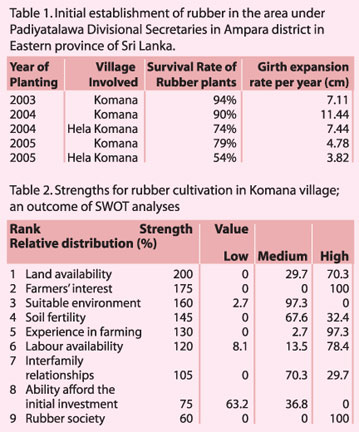Rubber in Eastern province ...
Continued from yesterday
Only six weaknesses were noticed, i.e. lack of knowledge on rubber
cultivation, problems associated with land ownership to secure subsidy
payments, lack of own finance, poor infrastructure facilities
particularly the poor roads, dry spells and seasonal demand on labour.
 Over 70% of farmers had no state clearance for their lands to
cultivate rubber. Later we discussed this matter again with the
Divisional Secretary of Padiyatalawa and he is prepared to issue
clearance certificates in consultation with the Forest Department as
previously mentioned. Despite all other problems, farmers are ready to
cultivate rubber if land clearance is given. Over 70% of farmers had no state clearance for their lands to
cultivate rubber. Later we discussed this matter again with the
Divisional Secretary of Padiyatalawa and he is prepared to issue
clearance certificates in consultation with the Forest Department as
previously mentioned. Despite all other problems, farmers are ready to
cultivate rubber if land clearance is given.
Out of the four opportunities listed, farmers perceived that
expansion of the rubber extension service in the region would be the
principal opportunity and this was followed by the financial benefits
from the rubber subsidy scheme.
Ability to confirm the land ownership with the cultivation of rubber
and chances for new income generating activities related to rubber
processing were the third and forth opportunities.
Unexpected droughts were ranked as the highest possible threat to the
rubber cultivation with ca. 40% farmers supposed to be in high risk
category. This confirms the needs of adaptive research on rubber
cultivation in this area. In general, a dry period of the area prevails
from March to September with some intermittent rains in April/May.
In order to minimise the impact of dry spells on plant growth,
well-grown poly-bagged plants with good root system i.e. plants raised
through the young budding technique could be used for planting together
with other cultural practices such as deep planting and mulching.
In particular, rice straw would be more suitable as a mulching
material due its high potassium contents which would help to alleviate
any moisture stress on rubber plants.
Also, planting with the onset of North East monsoon provides
sufficient time for plants to establish in the field before the
subsequent dry period. Diseases were ranked in the second place of
threats, however ca. 44% farmers perceived this as low level threat.
Cyclones were considered to be a medium level threat by most of
farmers. Sudden drop in rubber price and attacks by wide animals were
also threats to the rubber cultivation but ranked at the bottom in the
list.
Way foreword
Information gathered to date on growth of rubber and on social
aspects is in favour of the success of rubber cultivation in the region.
Initially, Intermediate zone is to be targeted and then it could
gradually be expanded to other areas once farmers are full aware on
cultivation practices of rubber and the required technology is developed
through adaptive research.
Farmers are ready to go forward, however for the success of the
programme, four responsibilities should be fulfilled by the government
organisation.
The Rubber Research Institute (RRI) is responsible for developing
suitable protocols for rubber cultivation in the region. To do so,
adaptive research trials as presently conducted are essential.
In addition, they are also to be involved in knowledge transfer
together with the Rubber Development Department (RDD). In particular,
the RDD should supply plants and other required materials (e.g.
fertilizer) on time. Divisional secretaries should attend to land
clearance matters enabling the RDD to issue permits for rubber
cultivation.
In state sector, one would rather sceptical about the success of such
coalition; however the track record to date has proven their ability to
work together. Writing letters and other paper work have been limited to
a minimum, obviously only if highly essential. Trust on one another and
the common interest to achieve the goal are dominant over all other
obstacles.
Knowing one other well, most of things are arranged over the
telephone. The National Science Foundation funded this project for one
year to conduct adaptive research trails at the beginning (Project No.
RG/2005/AG/14).
As this was not sufficient, the treasury has agreed to provide rupees
10 million from the budgetary allocation for 2008 to the RRI to purchase
a vehicle and to meet other special needs of this project. Our target is
to cultivate 100 acres of rubber in the present year and at a same pace
or above in following years.
Rubber cultivation within the Komana and Helakomana villages (Helakomana
GS division) showed an exponential increase with respect to both number
of farmers and the land area cultivated. Land availability in the
Helakomana GS division exceeds 400 ha. Setting a realistic target that
75% of those lands could be cultivated with rubber, 300 ha of rubber can
be planted in this GS division.
Assuming a similar situation in other GS divisions, rubber could be
cultivated in over 10,000 ha in the villages (37 GS divisions) coming
under Padiyatalawa and Maha Oya Divisional secretariats (mostly the
intermediate zone) of Eastern province. This is about 10% of the rubber
extent in the whole country.
Our ultimate aim is to achieve this target and with that there would
be a paradigm shift in the economy of this region. In addition to the
direct beneficiaries of rubber cultivation at present, i.e. smallholder
farmers, a market structure will develop benefiting non rubber farmers
too.
Rubber based industrialists would come to the region and therefore,
employment opportunities will create at various levels in down stream
production lines. Ultimately, at least about 45,000 people (thatís the
population in the intermediate zone of Eastern province) will be
benefited from this project.
(Concluded)
|

